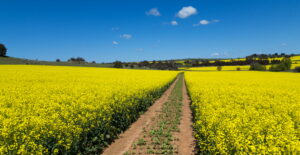It’s not often we can say this, but sometimes water can be more of a curse than a blessing. Aussie cropping zones have, on aggregate, copped their wettest JUL-OCT period in over 30 years, and the question is not if, but how much damage has been done, as the majority of cropping zones on the east coast are decidedly soggy, sorry, and at risk of becoming a feast for fungus.
More producers than not across the east coast have the eerie tune of “rain, rain go away” ringing in their heads, with no wish for it to come again any day soon as they survey waterlogged paddocks that are utterly untraversable, and in some regions jostle for impossibly rare aerial spraying slots to try and mitigate the damage.
Regular readers will have been introduced to the USDA crop explorer tool , which helps us quantify and visualize Australian rainfall, specifically over cropping areas.
When we examine the data presented on soil moisture models in the USDA visualisations, we can see that in Victoria, soil moisture in October hit now historical highs, at 340mm equivalent. (figure 1)
Similarly, the NSW model returned a new record high of over 350mm in early October.(figure 2)
In both states, the seasonal modelled seasonal moisture levels recorded were in excess of 40% over average conditions, and 10-15% above 2021 conditions. Also note the unprecedentedly steep jump in moisture levels in a short space of time, indicating the torrential downpours experienced.
Overall, the sheer amount of rainfall has undoubtedly led to damaged crops.
In southern NSW, there hasn’t been much opportunity to mitigate the issues, with Fred Fahey air services commenting that the effective spraying window for canola has already largely closed, as crop development is already too advanced. Fred also reported that during September, demand for aerial spraying far outstripped the number of days where conditions were suitable, suggesting that many crops missed out on receiving optimal treatments. This trend is unlikely to be restricted to one operator.
Further south in the Wimmera and mallee, the Ararat Advertiser reported that the aerial spraying season has started early as a result of the unseasonally wet weather. Agronomist Matthew Page of Nutrien Ag solutions Ballarat commented that there was currently in excess of a one week queue for aerial spraying contractors, which were predominantly working upon wheat and barley crops presently. He added that western Victorian yields were likely to be severely impacted in low lying, less well drained paddocks if another heavy 60mm+ rain event occurred in the next week or so.
Jon Mullaly, senior trader at Riverina stockfeeds produces a regular crop report, which you can sign up to access for free here. The Riverina model utilizes the historical relationship between rainfall and crop yields in various grain & oilseed growing zones across Australia.
The latest modeling results indicate that despite recent excessive rainfall, Riverina’s national wheat production forecasts to remain on an even keel at 34.4mmt, compared to the prior week’s estimates, barley to increase 1% to 12.75mmt and canola to drop back 1% to 6.86mmt. (figure 3) However, there is significant variability hidden behind the headline numbers, NSW forecasts have all slipped, with a 3% fall in wheat, to 9.5mmt, barley declined 1% to 2.35mmt and canola plummeted (4%) to 1.33mmt. In addition, Victoria saw falls in both barley and canola. Add to this the consideration that there is more rain on the way, so plenty of scope exists for further downgrades. In contrast, a counterbalancing force behind the national model results has been that predictions for WA and SA production have mostly improved.
Other analysts disagree on the national numbers however, with Dennis Voznesenski from Rabobank’s latest report, (which was released a few days ago) pegging the crop at much higher levels, with wheat at 35.5mmt, barley 14.8, and canola 7.2mmt. However, one point of consensus is that the outlook for Victoria is poised to worsen. Agronomist Ash DeClifford, from Nutrien Ag solutions Stawell, comments that the crop is under enormous disease pressure currently, and that Aerial spraying is the only option available. However, If disease has already infected a crop, canopy fungicides will not be effective at preserving yield.
On the quality side, the wet weather is expected to reduce wheat quality and a repeat of a substantially higher proportion of lower quality wheat is on the cards. Riverina estimates that last year saw 38% of the east coast crop classed as general purpose, or feed grade – more than triple that of a more typical, less damp harvest year that clocks in at 11%.
Wheat harvest has started in QLD, SA & WA, but Riverina’s estimates peg progress as being well behind average, with the outlook delayed due to more wet weather interfering with operations.
What does it mean?
Excessively wet weather all down the east coast will almost certainly lead to significant quality and quantity downgrades for all major winter crops. Smaller, lower quality crops will lead to an expectation of an improved price outlook for higher quality grains. Similarly, a delayed harvest window is likely to lead support to pricing for those producers able to deliver earlier in the season. Overall, expect more production forecast downgrades to accumulate in the coming weeks.
Have any questions or comments?
Key Points
- Flooding in cropping areas covering Northern NSW to Southern VIC
- Wettest July- OCT on record, crop yields and quality to be impacted.
- Jon Mullaly’s Riverina predictive models suggest NSW production forecasts for wheat down 3+%, canola down 4%+, barley down 1+%, so far, with more flooding and downgrades to come in both VIC and NSW.
Click on figure to expand
Click on figure to expand
Data sources: Riverina, USDA, Rabobank, The Ararat Advocate, Nutrien Ag solutions agronomy team

Categories
Have any questions or comments?
Click on graph to expand














